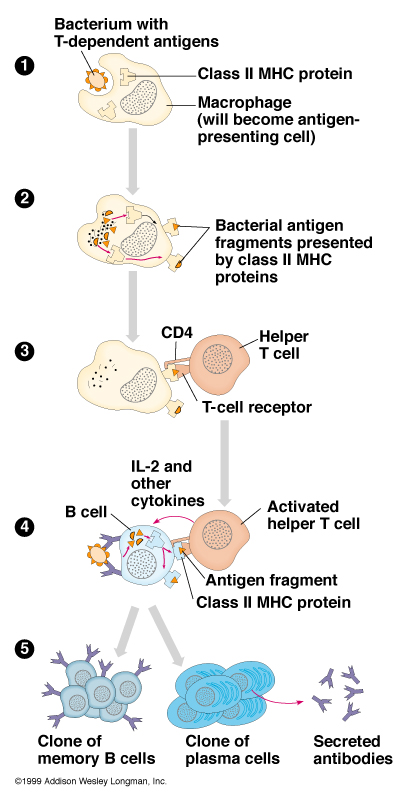
*This web page was produced as an assignment for an undergraduate course at Davidson College.
Humoral Response to N. fowleri

When N. fowleri invades a host, it can be phagocytosized by APC's. The APC's then go to the lymph nodes and presents the antigen to CD4+ helper T cells. The activated helper T cells then activate B cells which differentiate into memory B cells and plasma cells. The plasma cells then secrete antibodies which binds to N. fowleri.
Usually, N. fowleri can be destroyed by the complement cascade. In people with healthy, fully-developed immune systems or if the N. fowleri is not pathogenic, the complement cascade is initiated when a C1 complex attaches to an antibody that has already attached itself to an antigen on the N. fowleri. Then, C4, C2, andC3 are cleaved respectively by the C1 complex. The cleaved products attach to the surface of the N. fowleri and produces a C4bC2aC3b complex, which is a C5 convertase. Then, C5 is cleaved into C5a and C5b. C3b alone opsonizes N. fowleri and activates neutrophils. The neutrophils secrete TNF-alpha which increases the number of neutrophils in the vicinity. However, N. fowleri has CD59 proteins on in cell membrane which prevents N. fowleri from becoming eaten by phagocytes or lysed. Therefore, by resisting the complement cascade, N. fowleri is able to avoid death by the innate immune response.C5b then recruits C6, C7, and C8 and together, they help C9 polymerize at the cell surface and cause it to underdo lysis by creating holes in the cell membrane.
N. fowleri can also be recognized by the alternative pathway. In the alternative pathway, C3 convertase turns into C3 hydrolysis. C3 hydrolysis converts C3 into C3a and C3b. C3b cleaves C5 into C5a and C5b. C5b then recruits C6, 7, 8, and 9 to create a pore on the pathogen ( Holbrook, 1980).
To see how and why pathogenic strains of N. fowleri are able to avoid this, please go to the Evasion of the Immune System page.
http://faculty.plattsburgh.edu/jose.deondarza/Bio406/images/43.13%20Humoral%20response%20to%20a%20.JPG
If you have any question or suggestions regarding this site, please contact Alex Kim (alkim@davidson.edu)